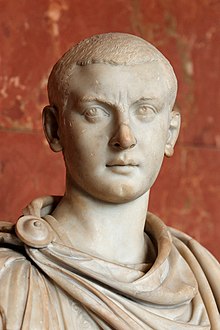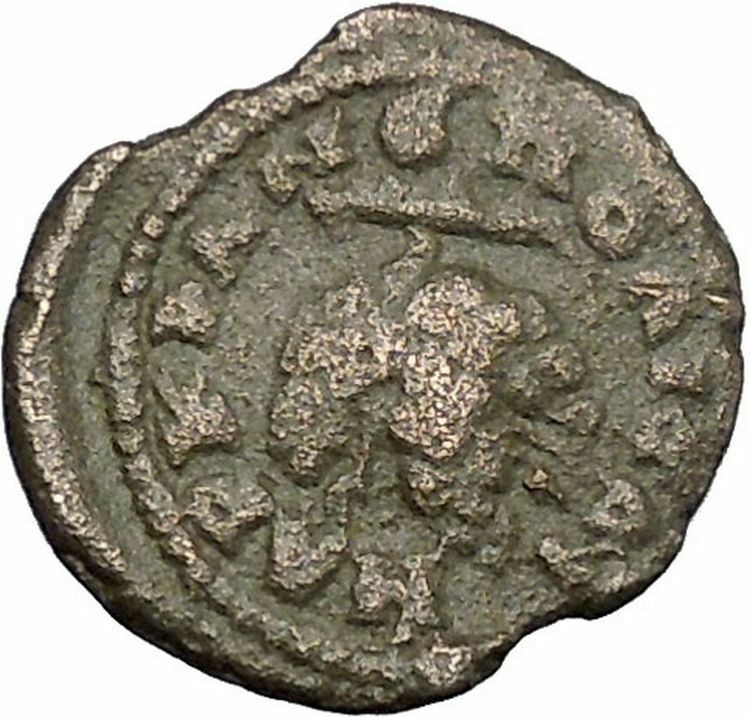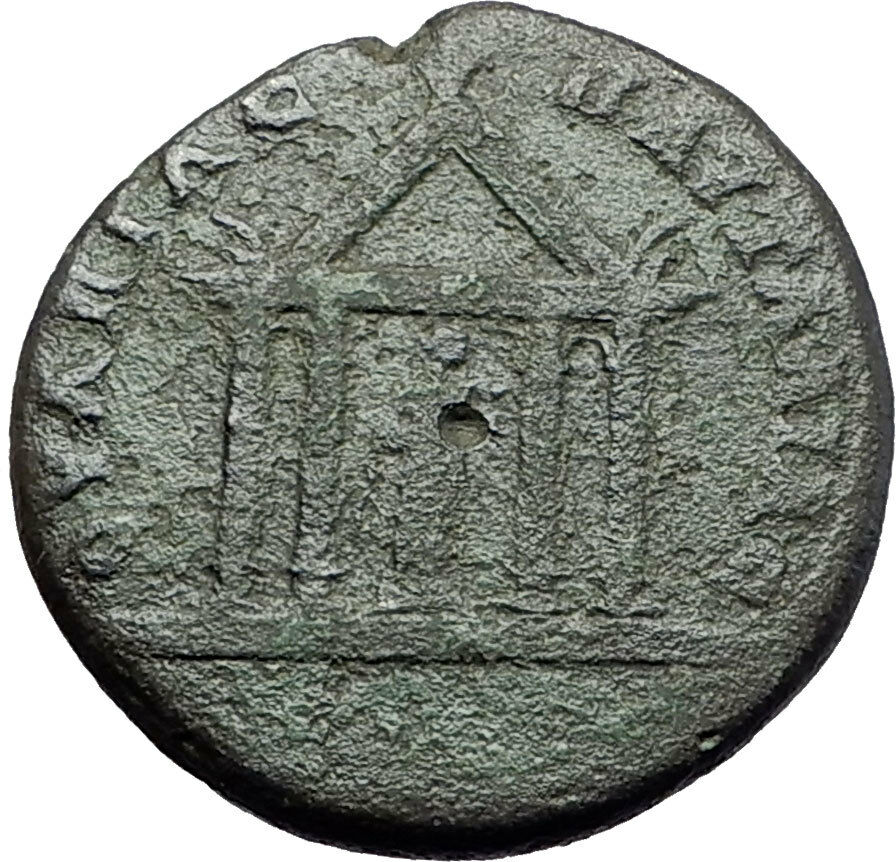|
Gordian III – Roman Emperor: 238-244 A.D.
Bronze 23mm (12.73 grams) of Thessalonica in Macedonia
Laureate, draped and cuirassed bust right.
ΘЄCCAΛONIKЄΩN KABЄIΡIA, Prize-urn containing one palm branch.
* Numismatic Note: KABЄIΡIA inscription brings alludes to the ancient celebration dedicated to the deities known as the Kabeirii. Very rare type.
You are bidding on the exact item pictured, provided with a Certificate of Authenticity and Lifetime Guarantee of Authenticity.
CABEI′RIA (καβείρια), mysteries, festivals, and orgies solemnised in all places in which the Pelasgian Cabeiri, the most mysterious and perplexing deities of Grecian mythology, were worshipped, but especially in Samothrace, Imbros, Lemnos, Thebes, Anthedon, Pergamus, and Berytos (Paus. IX.25 § 5, IV.1 § 5, IX.22 § 5, I.4 § 6: Euseb. Praep. Evang. p31). Little is known respecting the rites observed in these mysteries, as no one was allowed to divulge them (Strabo, X p470, &c.; Apollon. Rhod. I.917; Orph. Argon. 469; Valer. Flacc. II.435). Diagoras is said to have provoked the highest indignation of the Athenians by his having made these and other mysteries public (Athenag. Leg. II.5). The most celebrated were those of the island of Samothrace, which, if we may judge from those of Lemnos, were solemnised every year, and lasted for nine days. The admission was not confined to men, for we find instances of women and boys being initiated (Schol. ad Eurip. Phoen. 7; Plut. Alex. 2; Donatus ad Terent. Phorm. I.15). Persons on their admission seem to have undergone a sort of examination respecting the life they had led hitherto (Plut. Laced. Apophth. Antalcid. p141, ed. Tauchnitz), and were then purified of all their crimes, even if they had committed murder (Liv. XLV.5; Schol. ad Theocrit. II.12; Hesych. s.v. Κοίης). The priest who undertook the purification of murderers bore the name of κοίης. The persons who were initiated received a purple ribbon, which was worn around their bodies as an amulet to preserve them against all dangers and storms of the sea (Schol. ad Apollon. l.c.; Diodor. V.49).
Respecting the Lemnian Cabeiria we know that their annual celebration took place at night (Cic. De Nat. Deor. I.42), and lasted for nine days, during which all fires of the island, which were thought to be impure, were extinguished, sacrifices were offered to the dead, and a sacred vessel was sent out to fetch new fire from Delos. During these sacrifices the Cabeiri were thought to be absent with the sacred vessel; after the return of which, the pure fire was distributed, and a new life began, probably with banquets (Schol. ad Apollon. Rhod. I.608).
The great celebrity of the Samothracian mysteries seemsº to have obscured and thrown into oblivion those of Lemnos, from which Pythagoras is said to have derived a part of his wisdom (Iamblich. Vit. Pyth. c. 151; compare Müller’s Prolegomena, p150). Concerning the celebration of the Cabeiria in other places nothing is known, and they seem to have fallen into decay at a very early period (comp. Guthberlet, De Mysteriis Deorum Cabirorum, Franequerae, 1704, 4to.; Welcker, Die Aeschyl. Tril. p160, &c.; E. G. Haupt, De Religione Cabiriaca, 1834, 4to.; Lobeck, Aglaophamus, p1281, &c.; Kenrick, The Egypt of Herod, p264, &c.).
Thessalonica, more anciently Therma, an ancient city in Macedonia, situated at the N.E. Extremity of the Sinus Thermaicus. Under the name of Therma it was not a place of much importance. It was taken and occupied by the Athenians a short time before the commencement of the Peloponnesian war (B.C. 432), but was soon after restored by them to Perdiccas. It was made an important city by Cassander, who collected in this place the inhabitants of several adjacent towns (about B.C. 315), and who gave it the name of Thessalonica, in honor of his wife, the daughter of Philip and sister of Alexander the Great. From this time it became a large and flourishing city. Its harbor was swell situated for commercial intercourse with the Hellespont and the Aegean; and under the Romans it had the additional advantage of lying on the Via Egnatia, which led from the W. shores of Greece to Byzantium and the East. It was visited by Apostle Paula about A.D. 53; and about 2 years afterwards he addressed from Corinth 2 epistles to his converts in the city. Thessalonica continued to be, under the empire, one of the most important cities of Macedonia; and at a later time it became the residence of the prefect, and the capital, of the Illyrian provinces. It is celebrated at this period on account of the fearful massacre of its inhabitants by order of Theodosius, in consequence of a riot in which some of the Roman officers had been assassinated by the populace.

Gordian III – Roman Emperor: 238-244 A.D.
Caesar: 238 A.D. (under Balbinus and Pupienus)
Augustus: 238-244 A.D.
| Grandson of Gordian I | Nephew of Gordian II | Adopted Successor of Balbinus and Pupienus | Husband of Tranquillina |
Marcus Antonius Gordianus Pius (January 20, 225 – February 11, 244), known in English as Gordian III, was Roman Emperor from 238 to 244. Gordian was the son of Antonia Gordiana and his father was an unnamed Roman Senator who died before 238. Antonia Gordiana was the daughter of Emperor Gordian I and younger sister of Emperor Gordian II. Very little is known on his early life before becoming Roman Emperor. Gordian had assumed the name of his maternal grandfather in 238.
Following the murder of emperor Alexander Severus in Moguntiacum (modern Mainz), the capital of the Roman province Germania Inferior, Maximinus Thrax was acclaimed emperor, despite strong opposition of the Roman senate and the majority of the population. In response to what was considered in Rome as a rebellion, Gordian’s grandfather and uncle, Gordian I and II, were proclaimed joint emperors in the Africa Province. Their revolt was suppressed within a month by Cappellianus, governor of Numidia and a loyal supporter of Maximinus Thrax. The elder Gordians died, but public opinion cherished their memory as peace loving and literate men, victims of Maximinus’ oppression.
Meanwhile, Maximinus was on the verge of marching on Rome and the Senate elected Pupienus and Balbinus as joint emperors. These senators were not popular men and the population of Rome was still shocked by the elder Gordian’s fate, so that the Senate decided to take the teenager Gordian, rename him Marcus Antonius Gordianus as his grandfather, and raise him to the rank of Caesar and imperial heir. Pupienus and Balbinus defeated Maximinus, mainly due to the defection of several legions, namely the ParthicaII who assassinated Maximinus. But their joint reign was doomed from the start with popular riots, military discontent and even an enormous fire that consumed Rome in June 238. On July 29, Pupienus and Balbinus were killed by the Praetorian guard and Gordian proclaimed sole emperor.
Rule
Due to Gordian’s age, the imperial government was surrendered to the aristocratic families, who controlled the affairs of Rome through the senate. In 240, Sabinianus revolted in the African province, but the situation was dealt quickly. In 241, Gordian was married to Furia Sabinia Tranquillina, daughter of the newly appointed praetorian prefect, Timesitheus. As chief of the Praetorian guard and father in law of the emperor, Timesitheus quickly became the de facto ruler of the Roman empire.
In the 3rd century, the Roman frontiers weakened against the Germanic tribes across the Rhine and Danube, and the Sassanid kingdom across the Euphrates increased its own attacks. When the Persians under Shapur I invaded Mesopotamia, the young emperor opened the doors of the Temple of Janus for the last time in Roman history, and sent a huge army to the East. The Sassanids were driven back over the Euphrates and defeated in the Battle of Resaena (243). The campaign was a success and Gordian, who had joined the army, was planning an invasion of the enemy’s territory, when his father-in-law died in unclear circumstances. Without Timesitheus, the campaign, and the emperor’s security, were at risk.
Marcus Julius Philippus, also known as Philip the Arab, stepped in at this moment as the new Praetorian Prefect and the campaign proceeded. In the beginning of 244, the Persians counter-attacked. Persian sources claim that a battle was fought (Battle of Misiche) near modern Fallujah (Iraq) and resulted in a major Roman defeat and the death of Gordian III. Roman sources do not mention this battle and suggest that Gordian died far away, upstream of the Euphrates. Although ancient sources often described Philip, who succeeded Gordian as emperor, as having murdered Gordian at Zaitha (Qalat es Salihiyah), the cause of Gordian’s death is unknown.
Gordian’s youth and good nature, along with the deaths of his grandfather and uncle and his own tragic fate at the hands of another usurper, granted him the everlasting esteem of the Romans. Despite the opposition of the new emperor, Gordian was deified by the Senate after his death, in order to appease the population and avoid riots.
|











